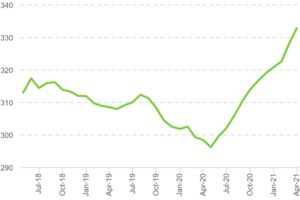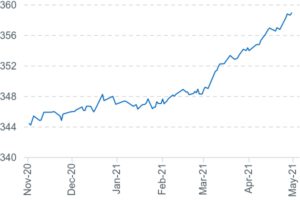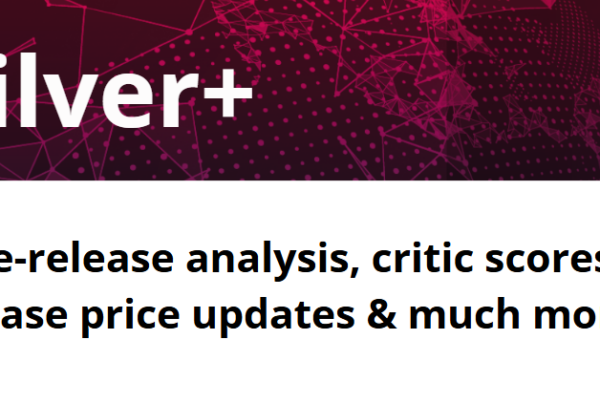Print and read offline instead.
The beginning of En Primeur 2020
- Liv-ex 100 index
- Liv-ex Fine Wine 50 index
With En Primeur almost upon us, interest in Bordeaux picked up – the recent 2018, 2017 and 2016 vintages dominating trade. The region closed April with its highest level of monthly trade share by value (44.2%) since June 2020, when the 2019 releases hit the market and stimulated demand. The past few days have already seen several 2020 petits châteaux releases such as Beaumont (JS 92-93), offered at 3.7% premium to the 2019, but at the same price level as the 2017; perhaps an indication of pricing to come?
With Bordeaux in sharp focus, Burgundy’s market share declined from 23.6% in March to 16.7% in April. Still, as recently examined, the Burgundy market is becoming broader and deeper with an increasing number of wine brands (LWIN7) trading. As for other regions, Champagne and California took equal parts of the pie, each accounting for 7.7% of trade by value. The Rhône accounted for 4.6%, and Italy took 14.8% (5.7% of which was Piedmont).
April was another strong month for fine wine prices. The Liv-ex 100 index rose 1.5% and the Liv-ex 1000 was up 1.3% – leading it into a previously uncharted territory. Within its sub-indices, the Rest of the World 60 rose the most (2.9% – see Major Market Movers below), followed by the Burgundy 150 (1.7%) and Bordeaux Legends 40 (1.2%).
The Champagne 50 remains the best-performing sub-index over one year, but its progress has slowed over the past few months allowing others – especially the Italy 100 – to begin catching up.
Chart of the Month – Fine Wine 50 vs FTSE100
The stability that fine wine offers as an investment asset is most evident when comparing its performance to mainstream financial assets.
Take the FTSE100, for instance, the UK’s leading equity index, and the Fine Wine 50, which tracks the movements of the most heavily traded (and thus most liquid) group of fine wines, the Bordeaux First Growths. Both indices have risen to similar levels (up 3% since their re-basement in January 2019) but they have experienced quite different levels of volatility during this time.
Faced with various market headwinds, including the Covid-19 pandemic, both indices saw spikes in volatility in early 2020. But while fine wine only drifted, the FTSE100 experienced a steep drop. Similarly, fine wine’s gains since have been gradual but far less volatile than the FTSE which has experienced a bumpy road to recovery.
In times of turbulence, fine wine can offer comparable returns to mainstream assets. What it adds is drinking pleasure and welcome stability.
Our next report, ‘An introduction to fine wine investment’, will be available next week.
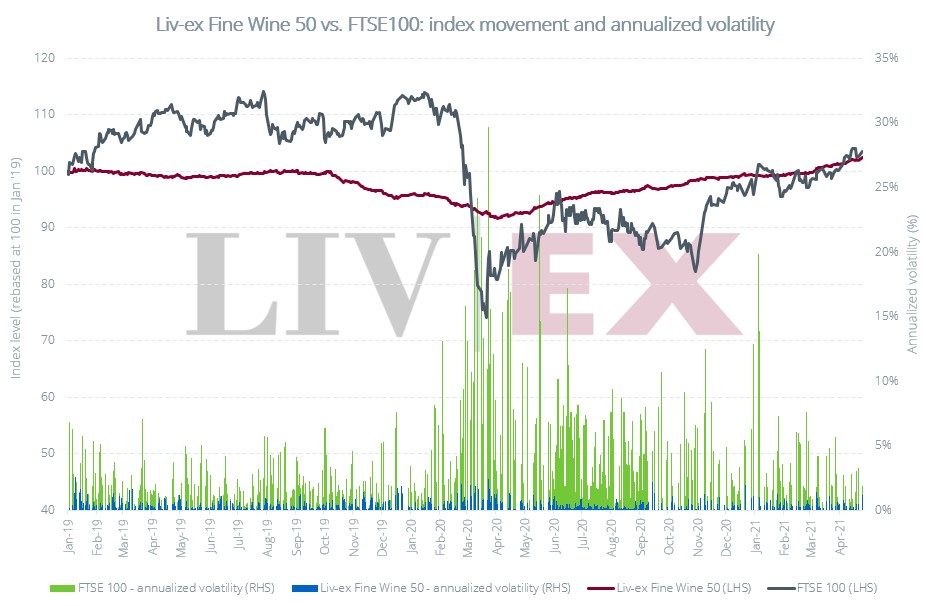
In the news: Tributes to Pio Boffa, and space-aged Pétrus 2000 auctioned
Pio Boffa, owner of Pio Cesare in Piedmont, died aged 66 after being hospitalised with Covid-19. A fourth-generation member of the founding family, he was described as, “a visionary and entrepreneur who transformed the family winery, Pio Cesare, during a four-decade tenure at the helm of the company”.
French businessman François Pinault was reported to have been exhorting his fellow Bordeaux châteaux owners to band together to save the city’s football club ‘Les Girondins’. The club has been placed under the protection of a local commercial court after its majority owner, American investment fund King Street, announced it no longer wished to support or finance it. The club requires €100 million to survive.
A bottle of Pétrus 2000 that was sent into space is being sold by Christie’s for an estimated US$1 million (£720,000). The bottle was one of 12 sent into orbit by Space Cargo Unlimited in November 2019, returning this January after 400 days. Presented in a bespoke case, the bottle is being sold alongside another bottle of Pétrus 2000 that has remained entirely Earth-bound.
Major Market Movers – Rest of the World rises

This month’s Major Market Movers came from best performing Liv-ex 1000 sub-index, the Rest of the World 60. The ROW60 index has underperformed over the past year compared to the broader market but saw a reversal of that trend in April.
Multiple vintages of Screaming Eagle led performance for the sub-index. The 2012 vintage, which carries a perfect 100 from Robert Parker, was up 11.5%. It was joined by its 2009 vintage, up 11.1% and its 2011 vintage, up 7.1%. All 10 vintages of Screaming Eagle in the ROW60 saw gains.
Also in the top movers table was Taylor’s 2016 Vintage Port, which also carries a 100-point score, from James Suckling. Vega Sicilia’s ‘Unico’ 2010 wrapped up the top five with a 4.4% gain.
Critical Corner – Top-scoring Bordeaux 2020
Which wines will be the critics’ favourites this year?
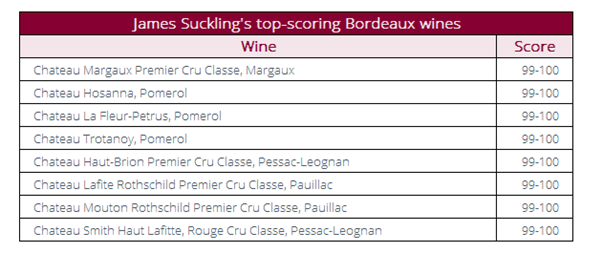
The first critical assessments of Bordeaux 2020 have been published – with several wines already beginning to look like front-runners. Comparing the top-scoring wines from James Suckling, Jean-Marc Quarin, and the team at JancisRobinson.com (the reports released to date), one can observe some repetition – particularly when it comes to the First Growths.
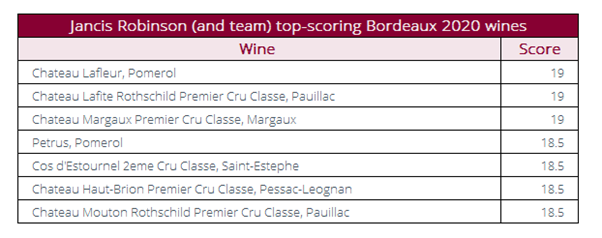
All of the First Growths still released En Primeur – Margaux, Mouton Rothschild, Lafite Rothschild and Haut-Brion – feature among the highest-rated wines from James Suckling and James Lawther MW (tasting for JancisRobinson.com). Lafite Rothschild was also favoured by Jean-Marc Quarin, who gave it 98 points.
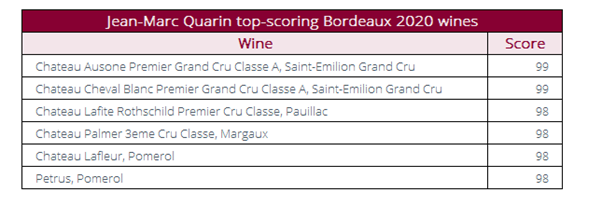
Lawther and Quarin also seem to concur on the quality of Lafleur (JR 19, JMQ 98) and Pétrus (JR 18.5, JMQ 98).
But scores rarely tell the whole story. Read a more in-depth critical overview of Bordeaux 2020, first vintage impressions, and comparisons to previous years in this month’s Final Thought (below). All the latest En Primeur critic scores can be found on our grid.
Final thought: Is 2020 a ‘Merlot year’ or a clay one?
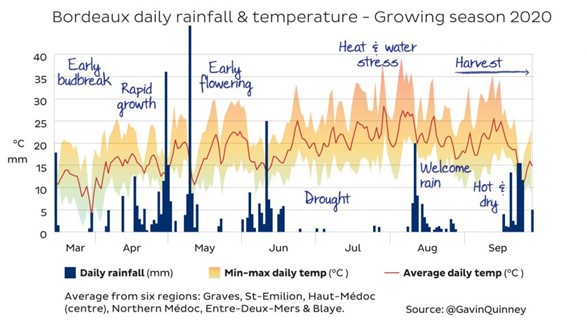
The first scores and impressions of the Bordeaux 2020 vintage are starting to emerge, and there seems to be a marked preference for the Right Bank.
James Suckling and Jancis Robinson MW have given some initial verdicts on the wines they have tasted. Some of their top scores can be seen in the ‘Critic’s Corner’ section of this report.
Nonetheless, both have expressed the opinion that 2020 is a vintage that has played into the hands of the Right Bank or those other appellations that use high proportions of Merlot, and sit on water-retentive soils.
“It seems to be a Merlot vintage to me,” said Suckling in one of his write-ups. This should, in part, come as no surprise. Although there was a hot summer in 2020, with a drought lasting 54 days between 18 June and 11 August, a lot of rain fell in April and early May.
Those vineyards on clay and limestone soils on both banks therefore will have had good reserves of water to draw upon during the worst of the summer heatwave. Being an earlier ripening variety, Merlot had the advantage of being picked before a further heat spike in September which was followed by a cool and rainy end to that month, which in turn had an impact on the Cabernets.
If any variety was going to shine in 2020 therefore, it was Merlot and this in turn broadly favours the Right Bank. Robinson wrote, “in very general terms, this most recent vintage seems to have been more successful, or at least more consistent, there than on the Left Bank”.
She singled out the wines of Saint-Emilion for particular praise. To her, 2020 marks continued progress in the AOC towards fresher, purer wines and moving further away from the high extraction, oak, and alcohol of previous vintages.
Although the Right Bank communes may have the edge, “this doesn’t mean that great Cabernet Sauvignon-based wines were not made in 2020 or that the Medoc did not make terrific young wines,” said Suckling.
So far, Suckling has given more 99-100-point scores to Left Bank wines than Right in fact. He even said that Haut-Brion might be his wine of the vintage while the Lafite, he said, “harks back to the great wines of the 1990s and 1980s”.
As mentioned above, the growing conditions certainly suited Merlot but also those appellations with soils capable of holding water. Appellations such as Pessac-Leognan home to Haut-Brion and where Robinson also found great consistency.
Before tastings began there were concerns that this was a good but heterogenous vintage. It increasingly seems that while there are excellent wines everywhere, if there is heterogeneity it is perhaps more localised in the Left Bank’s communes.
Neal Martin in his recent in-bottle report on the 2018s remarked on how it was a vintage that showed the gaps between the “haves and have-nots” when it came to terroir and cellar wizardry and it is possible that a similar comment could be made of the Médoc in 2020.
We shall see what further critics have to say in the coming weeks.
Our Bordeaux En Primeur 2020 page contains everything you need to know about this year’s campaign. You can also sign up for our daily En Primeur email alerts using the form below.



